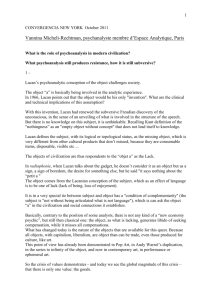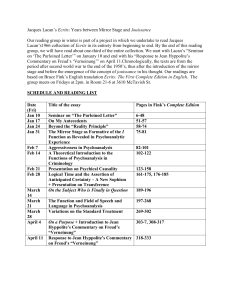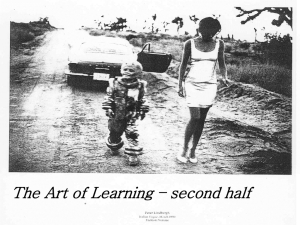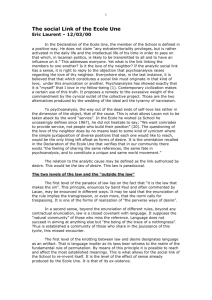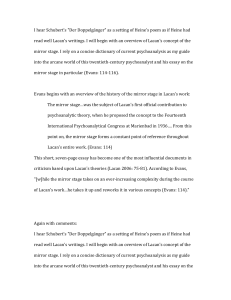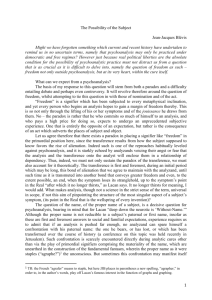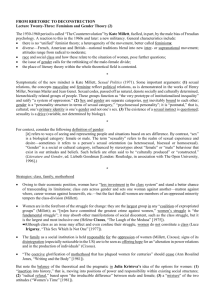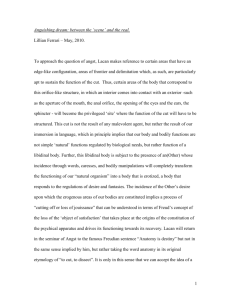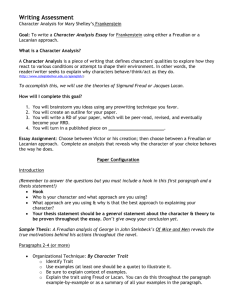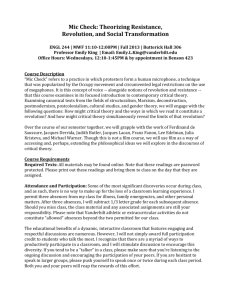Diana Rabinovich Don Juan As Slave
advertisement
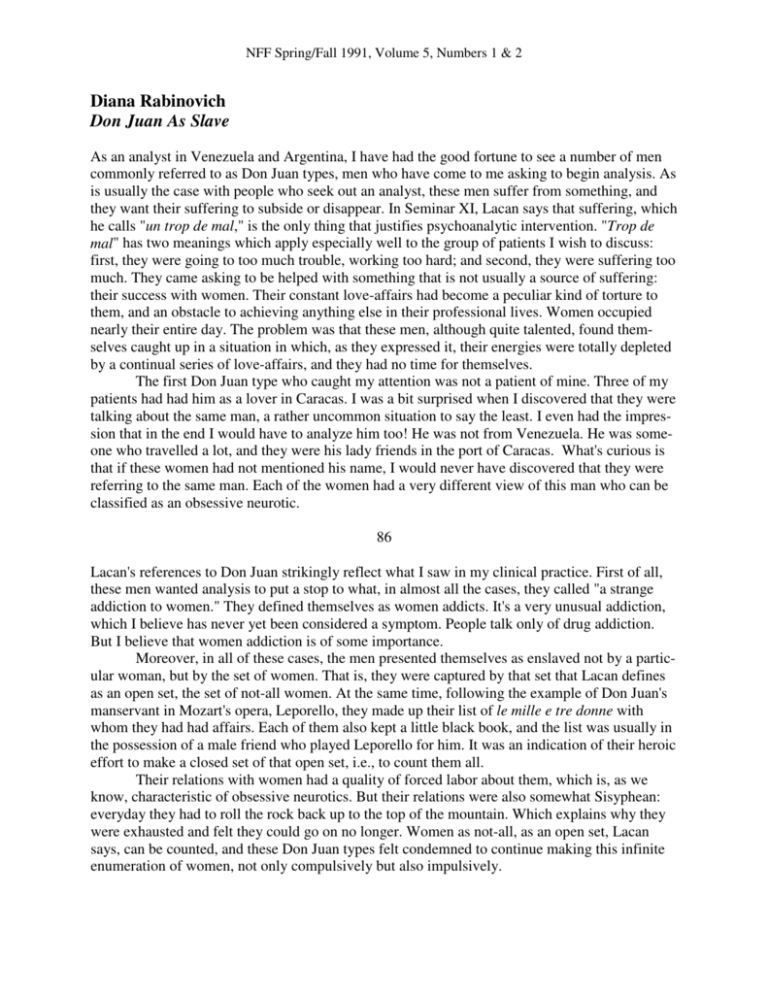
NFF Spring/Fall 1991, Volume 5, Numbers 1 & 2 Diana Rabinovich Don Juan As Slave As an analyst in Venezuela and Argentina, I have had the good fortune to see a number of men commonly referred to as Don Juan types, men who have come to me asking to begin analysis. As is usually the case with people who seek out an analyst, these men suffer from something, and they want their suffering to subside or disappear. In Seminar XI, Lacan says that suffering, which he calls "un trop de mal," is the only thing that justifies psychoanalytic intervention. "Trop de mal" has two meanings which apply especially well to the group of patients I wish to discuss: first, they were going to too much trouble, working too hard; and second, they were suffering too much. They came asking to be helped with something that is not usually a source of suffering: their success with women. Their constant love-affairs had become a peculiar kind of torture to them, and an obstacle to achieving anything else in their professional lives. Women occupied nearly their entire day. The problem was that these men, although quite talented, found themselves caught up in a situation in which, as they expressed it, their energies were totally depleted by a continual series of love-affairs, and they had no time for themselves. The first Don Juan type who caught my attention was not a patient of mine. Three of my patients had had him as a lover in Caracas. I was a bit surprised when I discovered that they were talking about the same man, a rather uncommon situation to say the least. I even had the impression that in the end I would have to analyze him too! He was not from Venezuela. He was someone who travelled a lot, and they were his lady friends in the port of Caracas. What's curious is that if these women had not mentioned his name, I would never have discovered that they were referring to the same man. Each of the women had a very different view of this man who can be classified as an obsessive neurotic. 86 Lacan's references to Don Juan strikingly reflect what I saw in my clinical practice. First of all, these men wanted analysis to put a stop to what, in almost all the cases, they called "a strange addiction to women." They defined themselves as women addicts. It's a very unusual addiction, which I believe has never yet been considered a symptom. People talk only of drug addiction. But I believe that women addiction is of some importance. Moreover, in all of these cases, the men presented themselves as enslaved not by a particular woman, but by the set of women. That is, they were captured by that set that Lacan defines as an open set, the set of not-all women. At the same time, following the example of Don Juan's manservant in Mozart's opera, Leporello, they made up their list of le mille e tre donne with whom they had had affairs. Each of them also kept a little black book, and the list was usually in the possession of a male friend who played Leporello for him. It was an indication of their heroic effort to make a closed set of that open set, i.e., to count them all. Their relations with women had a quality of forced labor about them, which is, as we know, characteristic of obsessive neurotics. But their relations were also somewhat Sisyphean: everyday they had to roll the rock back up to the top of the mountain. Which explains why they were exhausted and felt they could go on no longer. Women as not-all, as an open set, Lacan says, can be counted, and these Don Juan types felt condemned to continue making this infinite enumeration of women, not only compulsively but also impulsively. NFF Spring/Fall 1991, Volume 5, Numbers 1 & 2 This is important from a psychoanalytic point of view because their pursuit of women was not merely an obsessive compulsive symptom. Rather, they felt tempted all the time by nearly every woman who crossed their path. Considering that they had what we might call "phallic taste," it is clear, I believe, that nearly all women could fall into the category of being desirable. So you can imagine just how tired they were! That is why they talked about themselves as addicts. And like addicts, they always promised themselves that they would mend their ways--just as, for example, some people promise themselves one week after another, "On Monday I shall start a diet," or "I'll quit smoking," or "I'll stop taking drugs." These Don Juan types thus presented me with a somewhat paradoxical demand: they wanted to know how they could stop being successful with women. For not only did they suffer temptation, they were also rarely turned down by women. It was a very peculiar game which took up a great deal of their lives and which 87 also excluded--this is very important --prostitutes. Prostitutes were never involved in their affairs. I would like to turn now to Lacan's first important reference to Don Juan. There are two which are especially important: one is in Seminar X, L'Angoisse, anxiety--or anguish, I would prefer to say--and the other is in Seminar XX, Encore. In the two classes on March 20 and 27, 1963 in Seminar X, Lacan discussed the relation between jouissance and desire, the gap that exists between them, and the precise point where anxiety or anguish appears. The point where a gap exists between desire and jouissance is exactly the point where someone may feel anguished. Lacan states very clearly in Seminar X, especially in these two sessions, that jouissance is not related to or concerned with the Other (with a capital O) but with object a, i.e. it concerns the Other with a capital O only in an eccentric way. Object a serves as a substitute for the Other. In these two classes, Lacan describes two sets of fantasies (not the fundamental fantasy): feminine masochism and the fantasy of Don Juan. Don Juan is a feminine invention, and feminine masochism is a masculine invention. When we talk of jouissance, we must remember that Lacan speaks of jouissance in relation to the drives, especially the partial autoerotic drives. Jouissance is the satisfaction of the drive, or pulsion as he puts it in French. When he speaks of desire, on the other hand, he almost always speaks of the realization of desire, not of the satisfaction of desire. I'll return to this point later. One of the points that Lacan emphasizes in 1963 is that the distance between desire and jouissance condemns human beings, be they men or women, to different forms of debasement in their love life, and that the debasement of love life described by Freud in his famous article, which is only one of the many forms it may assume, is a structural facet of human sexuality. Lacan characterizes the masculine position in the following way. He says that, in the domain of jouissance, women are superior to men (and you must recall that this is a formulation made in 1963, that is, nearly ten years before Encore) insofar as women's bond with the knot of desire is less rigid. The lack or minus phi (-d), that is, the phallus as absence or lack that marks the phallic function for man, means that man's relation to object a necessarily involves the lack implied by the castration complex, i.e. the negativization that the castration complex implies, and that this lack or minus phi is instated in the center of man's desire. But although it is the center of a man's desire, it is not the center of his jouissance. Lacan says that NFF Spring/Fall 1991, Volume 5, Numbers 1 & 2 88 this structure, the relation between the lack involved in castration and desire, is not a necessary knot for women. He goes on to characterize man's anxiety as related to the possibility of "not being able to" [ne pas pouvoir]. Lacan says that true anxiety for men arises when they must let their desire show, and that this is not true for women. (The expression Lacan uses is laisser voir and he emphasizes that it has nothing to do with exhibitionism or voyeurism.) When a man must let his desire show he becomes anguished, Lacan says, for he must show what he does not have, what he only has by delegation from his father. Women, on the contrary, are from the beginning faced with the Other's desire as such. The phallic object appears to a woman only secondarily and insofar as a space arises in the Other's desire. This simplified relation to the Other's desire, Lacan says, puts women in a better position as psychoanalysts. He says in that same seminar that they are the best and the worst analysts, because they do not depend on their nature in relation to jouissance as much as men do. He cites the famous example of Tiresias who said that women's jouissance is much greater that men's. And then Lacan says something very close to what he develops in Encore. He says that what really anguishes women is related to the indeterminate, infinite possibilities of desire. (Lacan later changes this formulation because he comes to see desire as finite, not infinite.) He says that her problem is not to let her desire show, but to be tempted by tempting; that is, a woman is tempted by tempting men--tempting the other. What is important for her are signs that the other's desire has been aroused. Lacan emphasizes here that object a is intransitive, unlike desire which is always transitive. Object a, in its relation to jouissance, does not circulate socially; it is absolutely individual and private, because it is intimately related to the body The important point is that while one can identify with another's desire, it's very difficult to identify with someone else's object a. It can be done, but it is difficult, and it is not as obvious and simple as in the case of the structure of desire. Thus, for a woman, taking the other's desire as her object is one way of giving her desire an object that is proper for it. All of this situates, I believe, part of the problem associated with the logic of sexuation. There is a first logic of sexuation in Lacan, which is an Aristotelian logic centered on having or being the phallus. It follows the Aristotelian structure of logic, but it also has a Freudian tradition, which I suspect is well known. Lacan takes the difference between having and being from Freud's own work. 89 But this logic, in which the woman is the phallus and the man has to have it to resolve the Oedipus complex, is only one moment in Lacan's theory. In Encore (and even before), having and being are tied to the masculine formulas of sexuation. But they are not everything, and this is an important point: they are not limited to the strict logic of the signifier, but are closely related to significations, i.e. to a more imaginary determination of sexuality. Now when Lacan introduces Don Juan, he says that Don Juan is a feminine dream. What women dream of is a man who is perfectly equal to himself, a man who lacks nothing. Don Juan plays that part for women. Lacan insists that Don Juan's relation to the image of the father as non-castrated is really a feminine image, i.e., an image invented not by men but by women. Lacan says that there is, in a sense, a relationship between Don Juan's position and an image--not a symbol, but an image--of a non-castrated father, which gives part of its value to this dream NFF Spring/Fall 1991, Volume 5, Numbers 1 & 2 called Don Juan. At the same time, Lacan insists that Don Juan does not necessarily experience desire; all he experiences is, following Mozart's opera, il odore di femina: he smells women, but does not really desire them. He cannot resist them, but it is more a question of a certain jouisance than of desire. And Lacan says that, curiously, Don Juan does not arouse anxiety in women because a woman is really anguished when she feels that she is the center of desire. Since Don Juan only wants to enjoy her--he doesn't desire her--he is less a problem than someone who really desires her. Lacan goes on to explain that this Don Juan fantasy represents a wish on the part of women for an image that plays a peculiar function, namely that there exist a man whose position is such that no woman can possibly catch him, and that's what makes him "The Man." At the same time, Lacan says, Don Juan is a man who never lets himself get caught. (Lacan goes on to say that what is characterized in psychoanalysis as feminine masochism implies a masculine fantasy by which a man imagines women to be masochists because he seeks to arouse anxiety in them, signs that they are anguished by their desire for the other. I won't develop this because it would be ample matter for another paper involving different clinical cases.) What I want to indicate, using Lacan's first description of Don Juan, is that there is a point which is quite remarkable, clinically speaking: the Don Juan types were especially docile in the way they adapted themselves to women's fantasies, one by one, as is indicated by the fact that the man who had relations with three of my 90 patients didn't sound to me like the same man. He was especially concerned with saying the words each woman wanted to hear and figuring out exactly how each woman wanted him to talk. Don Juan types are thus really servants of a woman's fantasies, not of their own. In any case, their own fantasy is that they are capable of responding to all feminine fantasies. As you see, Don Juan types are in a very difficult situation, which I believe becomes clearer in Encore when Lacan, in the first chapter on jouissance, says that the space of sexual jouissance is a space covered by open sets that are finite and can ultimately be counted. This is how he defines capacity as a properly feminine space: he says, "Don't you see? What is essential to the feminine myth of Don Juan is that he loves them one by one." That is what the other sex, the masculine sex, is for women. In this regard, the image of Don Juan is crucial. Lacan also says that insofar as women are names, one can make a list and count them. If there are mille e tre, it is possible to count them one by one. That is exactly what Don Juan does, and this one-by-one is absolutely different from the One of universality or unity. What Lacan posits, then, is that sexuation implies the impossibility of establishing a "rapport" a word that can be translated as proportion or relation. The phrase, "there is no rapport," points at the same time, then, to the relation between men and women, but especially to proportion in a mathematical sense, i.e., to the possibility of the existence of a harmonious proportion between men and women, of complementarity between them, whose absence entails that there is no complementarity between the sexes. The problem of sex as harmonious or not is not new in Lacan. In Seminar XIV The Logic of Fantasy, working with a mathematical concept of proportion taken from Greek mathematics known as the golden number or golden mean, Lacan introduces the problem of the non-existence of a harmonious rapport with the mathematical foundation of object a as incommensurable. This points to what mathematicians call rational numbers, which raise a question regarding infinitely small fractions between any two integers. NFF Spring/Fall 1991, Volume 5, Numbers 1 & 2 Lacan uses the rational numbers, those that have no common measure with natural numbers, as an instrument to obtain a measurement of object a in relation to the One that is inscribed as a signifier--the One of the phallus. The point is that, in relation to jouissance, the phallus is not minus phi (-d) but Phi (e), the signifier of jouissance, not the signifier of desire--two very different things. And as the signifier of jouissance, it is taken by Lacan as a unit 91 measure of jouissance that makes it possible to calculate the object a's jouissance value. It is important to remember that that was when Lacan was developing object a as plus de jouir-surplus value of jouissance--and not as cause of desire. They are two different aspects of Lacan's elaboration of object a. What is important is that object a be defined as what is infinitely small, situated in the gap between two signifiers, S1 and S2. In its incommensurability it emerges as the only possible partner for both sexes. For both sexes, it is the locus of possible jouissance produced precisely by the construction of the signifiers as a chain. From Seminars XVIII to XXI, Lacan constructs his logic of sexuation, and the One of the phallus slowly shifts to the One exception that closes the universe of discourse. [. . .] Essence does not exist and all we have is existence; we may exist as men or women independently of our biological determination, but we never are men or women, according to Lacan. Logical existence implies something very different from Lacan's earlier logic of having or being the phallus, which Lacan now relegates to the imaginary order. The point is that being is always related to essence. Lacan does not accept essence as a concept because he believes that when one is captured by language, essence is lost, and that the action of the signifying system ultimately determines that there is no essence of masculinity or femininity for men or women. We exist logically as a product of the signifying system; we are men or women thanks to the action of the signifying system. If we now turn to the feminine side of the particulars, we can appreciate how a different logic comes into being. It is what Lacan calls a logic of duality, discordance, or disagreement, a logic according to which woman is two, with two different jouissances which are not complementary: they are both supplementary. He does this by including the negation of the quantifier, there exists an x ( x): "there doesn't exist an x that says no to the phallic function" ( x fx). This is important because what Lacan posits is that the absence of an exception on the feminine side implies the absence of the other sex, of the heteros as such. The other sex is thus absent, and in this sense there is no sexual rapport, because there are not two sexes. As Lacan says, "the other sex as such is absent." One of the partners has no logical existence, leaving a space or hollow where speech finds its place. If there is to be a foundation for sex, we'll need at least two. Lacan says that in the symbolic order, one and zero make two. The problem is that zero is only zero in the symbolic order, because, 92 Lacan insists, I believe from Seminar I on, that women lack nothing in the real. What is lacking is a signifier in the system of signifiers, and that is very different. Lacan continues to say, then, that this depletion or evacuation of the function of the Other allows us to see S() in a new way, NFF Spring/Fall 1991, Volume 5, Numbers 1 & 2 for this is precisely where object a acquires its proper function. That is why, in the little schema of sexuation, object a is on the feminine side and just under S(): it is the disappearance of the other sex that makes object a the only possible partner for both sexes, not for men alone. The absence of the exception also has consequences for the way in which the universal is founded, because the universal is founded differently for women than for men. The important point is that the negation, pas-toute or not-all, is the exact opposite of a mathematical limit. I want to eniphasize this point about limits because where we can have limits, even if we cannot talk about something, we can at least define its place--we can at least locate it. What analysis does with what cannot be said is to locate it and operate with it even when it is not said. That is how the word can operate on the real. But to do this it obviously has to operate on the subject, not on the real itself--i.e. it must always operate through the subject, the divided subject. Lacan later relates women as open set to the unconscious. In Seminar XXI, Lacan posits that the unconscious, like women, is an open set. This takes us back to our patients: do they correspond to a feminine fantasy? Are they enslaved to it? Who is the master at this point? The master is someone who is placed in the position of an exception, the exception which permits the set of women to become a closed set. As you might imagine, this exception is a mother. She is a very important character in the analysis of Don Juan types. All these men had in common their faithfulness to their mother, which made them unfaithful to all other women. The only woman to whom they were faithful was their mother as exception. She was the only woman who did not have to submit to castration. I'll give two examples of how the mother's role can change. Lacan says in Chapter 10 of Encore (it's the other reference to Don Juan) that every rapport of a man with a woman must be understood from the angle of the au moins une, the feminine exception. This one exception--the mother who is off-limits according to the fundamental prohibition of the Oedipus complex--has a very special place. When the mother's position is affected--and her position is 93 in certain cases occupied by the legal wife--Don Juan becomes free. One of the patients I've already described fell in love with a woman at a certain point in his analysis. Obviously something had happened. By falling in love with one woman, and not all of them, he discovered who Woman was, i.e., his mother--the only way Woman functions as a signifier for neurotic patients. This was quite clear, and was conveyed in an expression: un hijo amante. The way you pronounce it in Spanish is absolutely ambiguous. It may mean either a loving son or a son who is his mother's lover. When I isolated these words from what the patient was saying, repeated them and interrupted the session, he asked how he should understand the phrase. Obviously it was not up to me to say how he should understand it; it was up to him. Shortly thereafter, a love affair with one particular woman took place. He thus had to interrupt the more usual sort of love affair he was having with a lady who was a social worker. He said that he felt that he himself was a social worker. "Social?" I asked. "No," he said, "I'm really a sexual worker." Which was true: he was obsessed by the fact that women had to have their jouissance, and that was more important to him than his own. He really worked for women. He was not faithful, but he certainly was a worker. He shared this characteristic with a patient of someone I supervised. This other patient arrived at a similar point in his own analysis. Throughout the analysis he would say, "You know, NFF Spring/Fall 1991, Volume 5, Numbers 1 & 2 Ann X" (that was the name of his woman analyst), "all women want the same thing." When the analyst asked, "What is that," he replied, "Oh, you know." This happened many times, until one day a similar situation occurred: he fell in love with one particular woman. He told his analyst that he had really thought about it and concluded that this woman must be like all the others. The analyst asked, "What does it mean that they all want the same thing?" "Well, you know, they are all whores," he replied. The analyst then intervened for the first time. She interrupted the session and said, "Gracias, por el cumplimiento", which means something like, "thank you for the compliment," but is at the same time very ironic, meaning, "I am included in that series of women; I'm no exception." I believe that the important point of this interpretation, in which there was a calculated vacillation of neutrality (because this analyst acted as if she were angry or offended, in a sense), was that she wanted to stop being the exception, knowing that she had been 94 placed in the same role as the patient's mother and afterwards his wife. Putting herself in the series shows how you can make a logical interpretation independent of the signified. By saying this, she obviously opened the set that had been closed. It produced a very intense reaction in the patient, as in the patient I spoke of before. And as a consequence-and this is what is important for us as analysts--a new moment of analysis became possible: something along the lines of what Lacan calls going from father to worst (du père au pire). The worst is object a--not the phallus that these men were for their mothers and wives and that they had to be for all the women in the world, that closed set, but precisely what appeared after a time of negative transference, which was difficult for the analyst because it had to be faced and gotten beyond. For the first time, something appeared which being the phallus had obscured: for both of these men, their mother's voice functioned as object a, cause of desire, a voice that was never audible and that, in the guise of the phallus as instrument, they obeyed. We are only now starting to construct their fundamental fantasy. There is something beyond the father that may permit these men not to be slaves to their mother's desire, not only in that they had become Don Juan types, but also because they had really submitted to this voice which made them, in daily life, very difficult individuals who frightened people. 95
